Discover the local tips on the best things to do in Trondheim: as Norway’s third-largest city, home to 210,000 residents and 40,000 students, Trondheim radiates an open-minded spirit and boasts a rich history and lively culture. Nestled along the jagged western coast, just north of the famed southwestern fjords, is a perfect gateway to the less-explored central region of Norway and offers numerous intriguing things to do and one of the most dynamic and surprising culinary scenes in the country.
Trondheim is also a popular stop for the Hurtigruten, the iconic coastal express that winds its way from Bergen to Kirkenes, as well as for numerous cruise ships touring the area. This is why many visit it in just a few hours, but let me tell you, it’s well worth spending at least a few nights to explore its museums and attractions, its beautiful surroundings, and its welcoming atmosphere.
Once the capital of Norway, Trondheim combines vibrancy and modernity with a rich cultural heritage. Stroll through the alleys of its old town with its colorful waterfront houses to discover its fascinating past, among ancient cathedrals and merchant houses that tell stories of Vikings, medieval kings, and hardy fishermen.
What you’ll find in this guide to the Best Things to Do in Trondheim:
Trondheim: What to Know Before Going
Trondheim is one of the oldest cities in Norway and boasts a fascinating history and cultural heritage. Founded in the year 997 by Viking King Olaf I of Norway, it was initially known as Kaupangen, a name that was soon changed to Nidaros. It was here that the nation took root, and Nidaros served as the capital of Norway until 1217, when Norway ended up uniting with Denmark and Sweden, forming a single country that would last many centuries. Consider that Norway only returned to being an independent state in 1905!
The most significant testament to its past is the imposing Nidaros Cathedral, a Gothic masterpiece erected in 1070, which once served as a solemn venue for the coronation of Norwegian monarchs. Nestled along a tranquil fjord, on whose banks one of the most important ports of Central Norway is located, the city is today a primary hub for transport in the region and has gracefully evolved into a thriving, modern city.
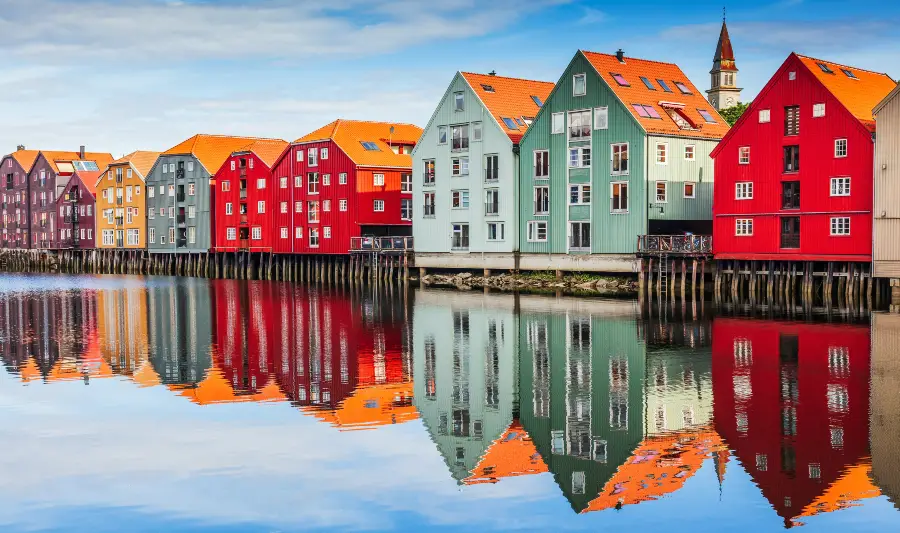
It’s home to one of Norway’s premier universities, and its substantial student community makes it vibrant in any season. There’s always something going on in the city, from concerts and events to exhibitions. The city also stands proudly as one of the country’s primary centers for cutting-edge scientific and technological research, making it a hub for innovation and progress.
But Trondheim is not just about its illustrious past and promising future. It’s a vibrant, bustling city that offers a plethora of experiences for travelers. Its charming old town, with narrow streets and colorful houses, invites exploration. The serene Nidelva River winding through the city creates picturesque scenes, perfect for leisurely strolls. The fusion of history, culture, and modernity makes Trondheim a vibrant and enjoyable destination, perfect to explore in just a few days.
Best Things to Do in Trondheim
Most of the attractions and things to see in Trondheim are located in the city center, which is easily explored on foot. The city is quite compact, and several public transportation lines allow you to reach almost all the attractions in the surrounding area. For those arriving from the port or the train station, the city center and the riverside walk leading to the colorful houses of the Bakklandet district can be reached with an easy half-hour walk.
Nidaros Cathedral
The Nidaros Cathedral is one of Norway’s most significant churches and the northernmost medieval cathedral in the world. It was built in 1070 on the burial site of King Olaf II of Norway, who was killed during the Battle of Stiklestad in 1030. King Olaf II is renowned for introducing Christianity to Norway, which is why he is now considered the country’s patron saint.
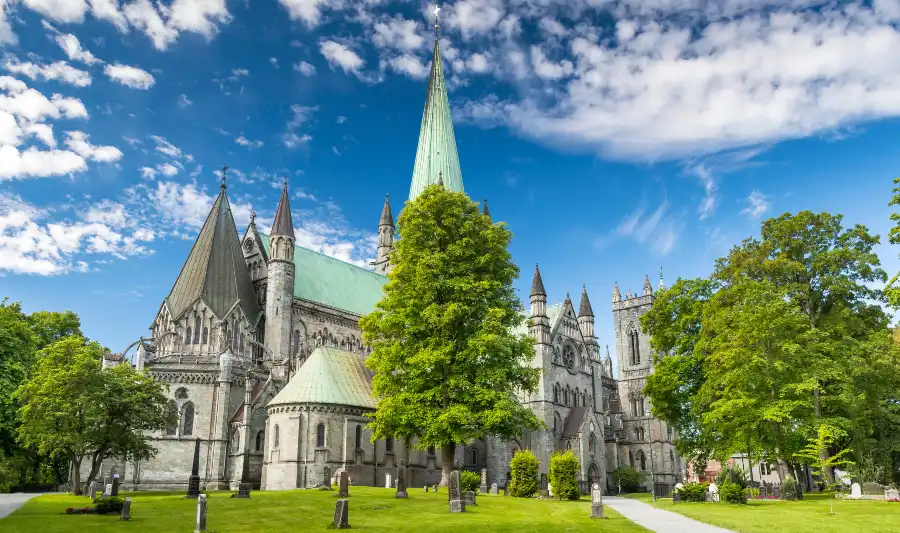
Historically, the Nidaros Cathedral served as the burial site for Norwegian kings and the location for coronations, which took place here from the 1400s. The ceremony was only recently moved to Oslo, following Norway’s regained independence in the early 1900s. Over the centuries, the Nidaros Cathedral has increasingly become one of the primary pilgrimage destinations in Northern Europe, still marking the endpoint of the St. Olav’s Way (Pilegrimsleden), also known as the Old Kings’ Road.
Despite suffering damage from devastating fires on multiple occasions, it remains one of Norway’s most important and captivating churches—a monumental stone church that stands as a result of centuries of restoration and reconstruction efforts, resulting in a true masterpiece of Gothic and Romanesque architecture. Its distinctive feature is the imposing facade adorned with sculptures of saints and kings flanking a large rose window, along with smaller sculptures such as masks, angels, and various animals, including bears, donkeys, elephants, roosters, and bees.
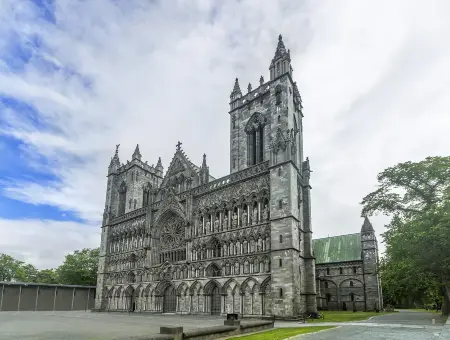

While the interiors are often underestimated, they are worth a visit. Despite the dimly lit and somber appearance, the cathedral maintains a majestic and solemn atmosphere with spacious naves, high ceilings, and numerous stained glass windows along the walls. The oldest part is the octagon, situated at the original location of the early church altar, which has remained intact for over a millennium.
The cathedral also houses some precious treasures, including the remains of Saint Olav and a Baroque organ from 1738. A narrow and steep staircase leads to the underground crypts, which host a collection of ancient marble tombstones. During the summer months, visitors can also climb the 172 steps—somewhat dark and narrow—leading to the top of the tower, providing a nice view of the city.
Archbishop’s Palace Museum
Trondheim is also home to the Crown Regalia, the crown jewels of Norway. This fact alone underscores Trondheim’s importance to national history. When visiting the Nidaros Cathedral, you should not miss a visit to the Archbishop’s Palace, located right next door and dating back to the 12th century. An imposing masterpiece of Romanesque-Gothic architecture and considered one of the largest medieval stone structures in Scandinavia, the Archbishop’s Palace served for hundreds of years as the headquarters, residence, and administrative center of the Archbishop of Nidaros.
The Archbishop held administrative, religious, and military command over the entire region, and had his own army and currency. The palace’s role shifted dramatically following the 16th-century Reformation, which marked Norway’s conversion to Lutheranism. The last Norwegian archbishop, Olav Engelbrektsson, made a valiant attempt to resist and defend the palace but ultimately fled into exile, leaving the property to fall into the hands of the king. It was during this period that the ancient archbishop’s castle transformed into a residential palace.
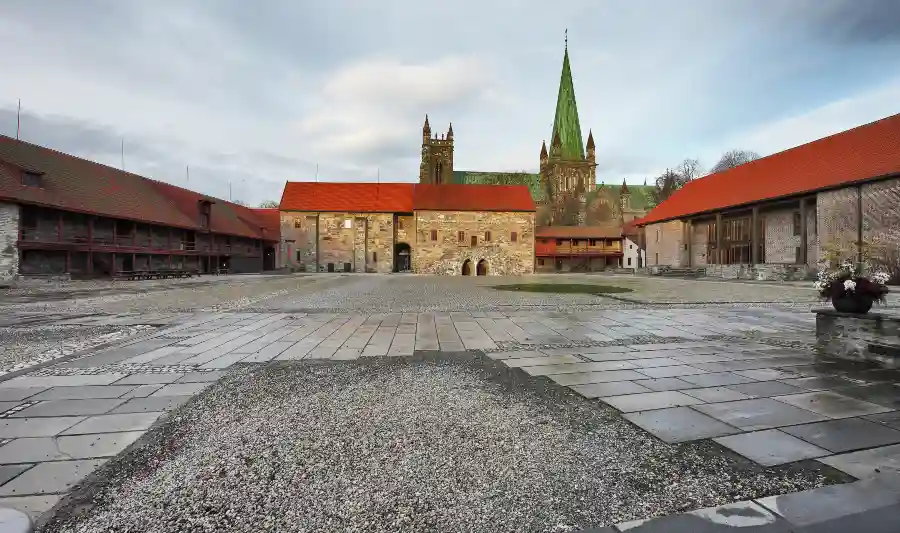
In 1983, a devastating fire destroyed two of the grand buildings of the Archbishop’s Palace. These were later rebuilt and today, they house the the Archbishop’s Palace Museum and the intriguing Army and Resistance Museums, dedicated to the region’s military history from the Viking era to World War II. The west wing of the palace, however, holds the collection’s highlight – the royal insignia.
Here you can see the jewels that belonged to the kings of Norway, including the royal scepter and the 200-year-old Crown of Norway, resplendent with precious gems and topped by an amethyst cross. The museum also showcases a collection of archaeological artifacts from the Nidaros Cathedral, with an exhibition illustrating its evolution through the centuries. Recent excavations have also unearthed the remains of the ancient mint, now the focus of a small dedicated exhibition.
Bakklandet
Undoubtedly, the most popular thing to do in Trondheim is a stroll through Bakklandet, one of the city’s oldest and most charming neighborhoods. Its picturesque and colorful houses are probably the city’s most recognized picture, particularly the Nidelva Waterfront with its evocative colored waterfront houses.
Bakklandet is located on the east side of the Nidelva River, between Bakke Bridge and the Old Town Bridge (Gamle Bybro). The neighborhood’s construction dates back to the early 17th century and was originally a working-class area, where living conditions were mostly poor. The residents here were craftsmen, small traders, and laborers.
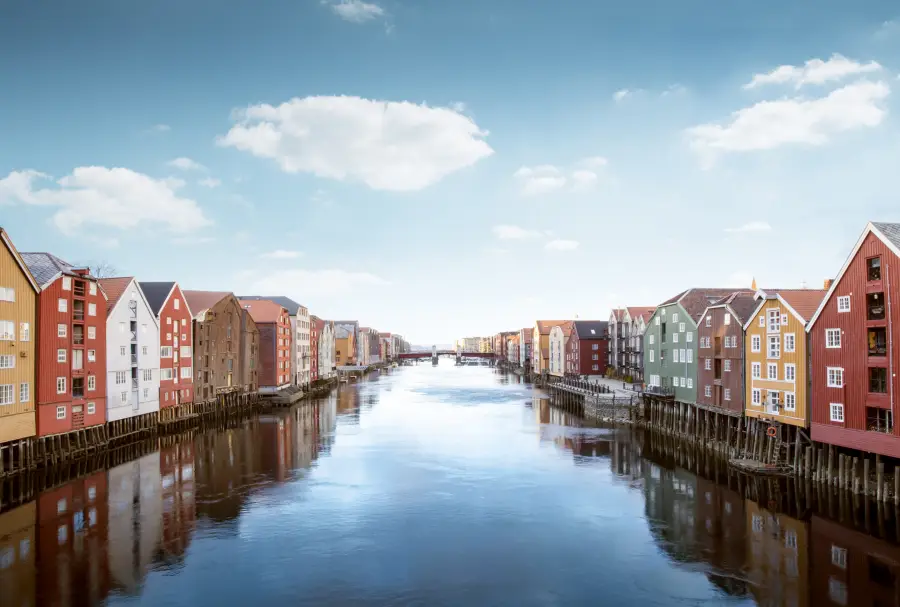
Over time, it was repeatedly damaged by various fires that devastated the city, and two Swedish sieges tested its existence, but the neighborhood was always rebuilt. Despite being considered a symbol of the city today, in 1965 the city administration wanted to demolish it to build a four-lane highway in the heart of the city center. This sparked widespread protests from residents, so the project was shelved and never proposed again.
Today, Bakklandet is effectively the historic center of Trondheim, consisting of a compact core of old houses in a typical traditional style. Explore it on foot, strolling through its cobblestone streets, lined with small shops, craft workshops, restaurants, and cafes. The most beautiful view is between Bakke Bridge and the Old Town Bridge: along the east side of the Nidelva River you can see the heart of Bakklandet, consisting of a series of painted wooden warehouses dating back to the 17th century.
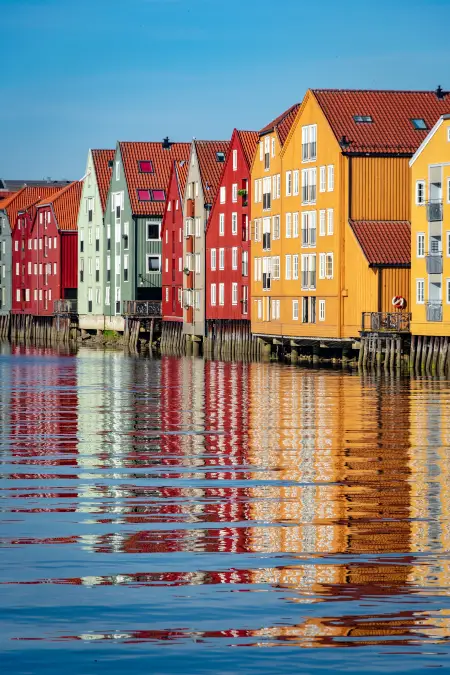
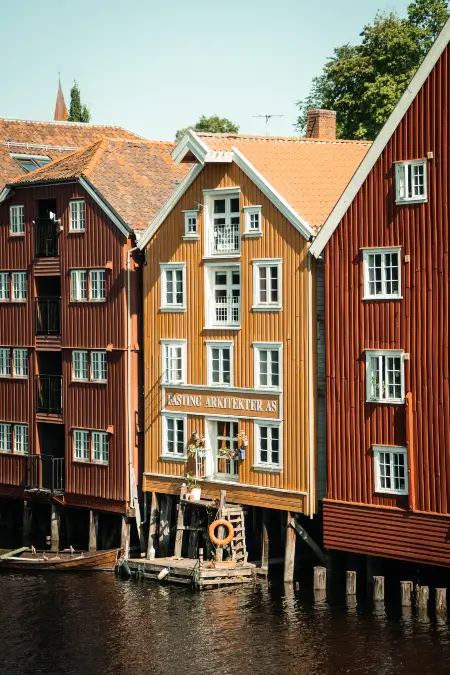
Here, you might want to stop at one of its best traditional restaurants and bars, such as Baklandet Skydsstation, known for its regional cuisine menu and over 350 varieties of akvavit to try, housed in a well-preserved 18th-century historic building. It’s worth stopping for its calm and relaxed atmosphere, good reindeer stews, and fish soups. A great alternative is the nearby Kalas og Canasta, which offers an excellent seasonal menu focused on fresh, locally sourced ingredients.
Among the most renowned cafes and pubs are Antikvariatet, popular for its cozy atmosphere, with books, candles, and live music, and also boasts a decent selection of draft and bottled beers. Locals also love the nearby Den Gode Nabo, another traditional bar with wooden furnishings, which serves good draft beers on an outdoor terrace overlooking the river during the beautiful seasons. For a sweet breakfast, artisan pastries, or a hot coffee, go to Kaffebrenneriet, a very popular cafe among locals, located right on the main street, called Nedre Baklandet.
Gamle Bybro (Old Town Bridge)
The Gamle Bybro, also known as the Old Town Bridge, is arguably the most iconic place to visit in Trondheim. It offers one of the finest views of the Nidelva River, the charmingly colorful houses of Bakklandet, and a glimpse of the Trondheim Fjord in the distance. This ancient and picturesque bridge spans the Nidelva River right in the Bakklandet neighborhood.
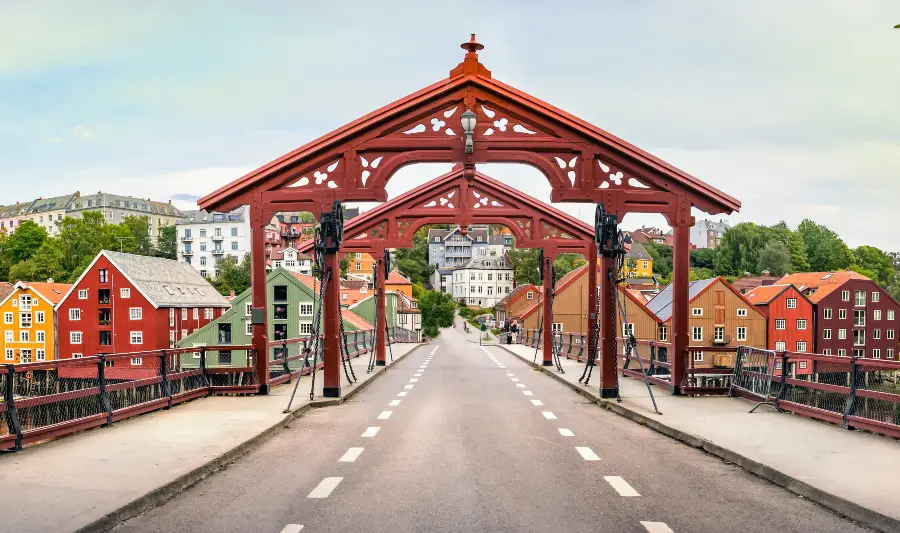
Constructed in 1681 by the military engineer Johan Caspar von Cicignon, the Gamle Bybro played a crucial role during the reconstruction of Trondheim after the devastating fire of the same year. Originally made of wood, the bridge served as a guarded city gate until 1816. At each end of the bridge stood a toll booth and a guardhouse. Today, only one of the access houses remains visible—the one on the western end.
The current appearance of the Gamle Bybro dates back to the 19th century, thanks to the work of the city engineer Carl Adolf Dahl. Locals affectionately refer to it as the “Lykkens Portal” or “Gate of Happiness”, inspired by the lyrics of the popular Norwegian waltz titled “Nidelven stille og vakker du er” or (“Nidelven, quiet and beautiful you are”), by singer and composer Kristian Oskar Hoddø. According to tradition, Hoddø composed this waltz while standing at the Gamle Bybro one night in late April 1940. He was a member of the Norwegian resistance movement against the Nazi occupation and was executed in Trondheim on November 17, 1943, along with eight other resistance fighters.
Torvet (Trondheim Town Square)
Torvet is Trondheim’s main square and serves as a focal point for locals. Dating back to 1681, the square underwent a complete renovation in 2010. At its center stands the statue of Olav Tryggvason, Norway’s first king and the city’s founder. Interestingly, the statue doubles as a sundial, with its column casting shadows upon the mosaic of cobblestones below.
The square is surrounded by numerous cafes and restaurants. At the southern end, you can often find various stalls selling fresh local produce, flowers, and souvenirs. Benches, tables with chairs, trees, and 25 flowerpots adorn the square, some featuring angular sculptures. Try to find the one that depicts Super Mario and Donkey Kong!
The square also hosts several events throughout the year. One of the most important is the Trøndelag Food Festival, one of the most important local food festival in Europe. It takes place in the summer, in the early days of August, when the square and the city fill up with over 200 food stalls where you can taste the best regional food, from the Fosen peninsula’s mussels to the reindeer from the Røros plateau.
And if you visit Trondheim during the Christmas season, don’t miss the wonderful Trondheim Christmas Markets in Torvet. For the occasion, the square fills up with stalls selling delicious local specialties, sweets, and handicrafts. Children will be amazed by the many rides and attractions that enliven the Christmas markets.
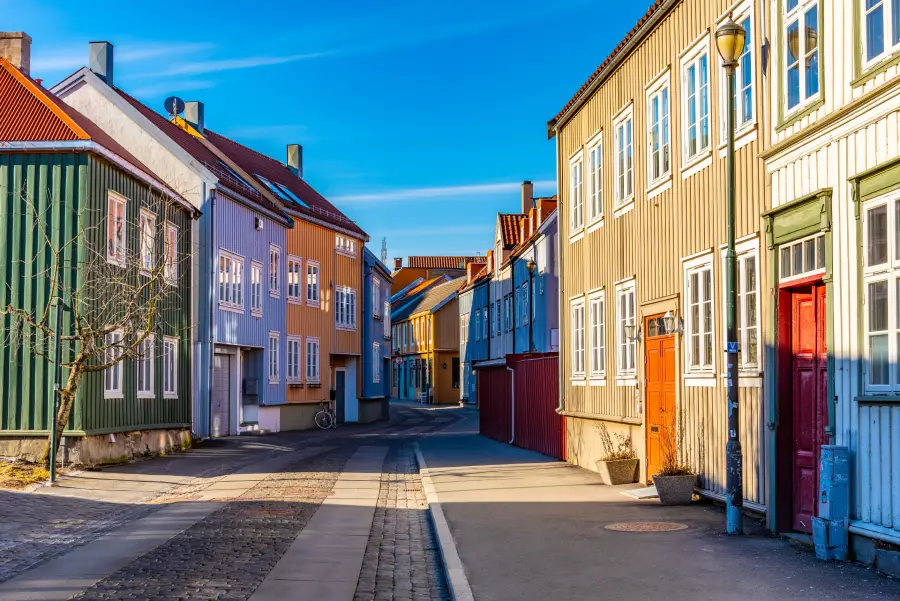
Kristiansten Fortress
The Kristiansten Fortress, perched on a hill to the east of the city, offers a magnificent view of Trondheim and its surroundings, the fjord, and the mountains. It was erected at the end of the 17th century, designed by Johan Caspar von Cicignon, the same engineer who oversaw most of the reconstruction following the fire of 1681.
This fortress was one of the city’s main defensive structures and played a crucial role, especially during the Swedish siege in 1718. However, one of the most dramatic chapters in its history occurred during World War II when the Nazis used it as a prison and execution site for members of the Norwegian resistance. After the war ended, the roles reversed, and it became the execution site for Nazi spies, traitors, and war criminals, including the infamous Henry Rinnan, a Norwegian agent for the Gestapo, who was executed here on February 1, 1947.
Today, it houses a small museum that provides an overview of the history of the Kristiansten Fortress and the events related to the Nazi occupation, through artifacts and informative panels. Visitors can see what were once used as cells for prisoners, and then stroll in the extensive surrounding park, where cannons and other historical objects are displayed. Admission is free.
Sverresborg Trøndelag Folkemuseum
Nestled near the ruins of Sverresborg Castle, the first Norwegian medieval castle built by King Sverre Sigurdsson, who reigned from 1177 to 1202, the Trøndelag Folk Museum stands as one of Norway’s most captivating open-air ethnographic museums. This museum, established in 1909 by a group of enthusiasts, was created to preserve the history and culture of the Norwegian people and the native Sami through a collection of buildings and objects characteristic of the area.
The museum, a village in its own right, is composed of over 80 historic wooden houses that once graced the historic center of Trondheim and the surrounding region, known as Trøndelag. A visit to the museum transports you to a different era, as you wander through three thematic sections. The first, the Old Town, showcases the charming wooden buildings that once stood in the heart of Trondheim, including the dentist’s house, the post office, the old grocery store, and the shoemaker’s workshop.
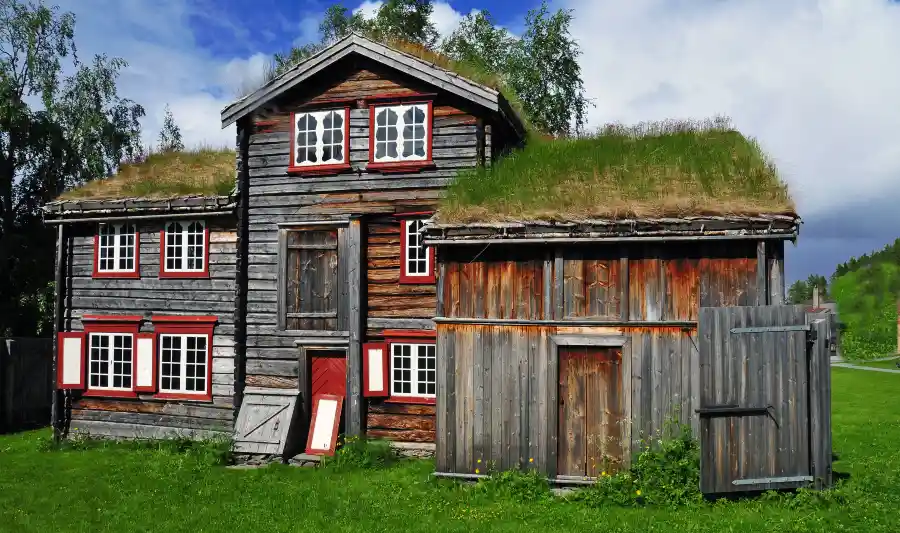
Next, you can explore the Rural Village, home to the museum’s crown jewel: the Haltdalen Stave Church, a stunning wooden church dating back to 1170. Here, you can also see an old school, some farms, and old wooden houses, offering a glimpse into the culture of the local population, fishing practices, and the nomadic life of the Sami, the people of Lapland. Lastly, the 12th-century castle ruins provide a fascinating insight into King Sverre’s rise to power and offer an unparalleled view of Trondheim and the fjord.
Located just outside the city center of Trondheim, the Trøndelag Folk Museum is easily accessible for travelers by car, with a parking lot conveniently located right in front of the museum entrance. Alternatively, bus n. 11 from the city center heading to Stavset will drop you off at the Trøndelag Folkemuseum stop.
Ringve Museum
If you have a specific passion for the history of musical instruments, then you shouldn’t miss out on the Ringve Museum, which is undoubtedly among the most fascinating of its kind. Located on the Lade Peninsula, it is entirely dedicated to Norwegian and European music, ranging from classical musical instruments to the latest sound and lighting technology.
Housed in an 18th-century manor overlooking the city and the fjord, the museum was once owned by the Bachke family, known for spending all their money collecting musical instruments from around the world. Inside the manor, their rich collection is on display, boasting over 2,000 ancient musical instruments. The interiors and furnishings of the house provide a backdrop to the exhibition, which is spread across multiple rooms named after illustrious musicians and singers, such as the Mozart, Chopin, or Beethoven.
Here, you’ll find 16th-century violins, ancient pianos, organs, harpsichords, and percussion instruments belonging to ancient African tribes. However, the museum is worth a visit even just to see the wonderful historic estate, surrounded by a splendid botanical garden with over 2,000 species of plants and trees.
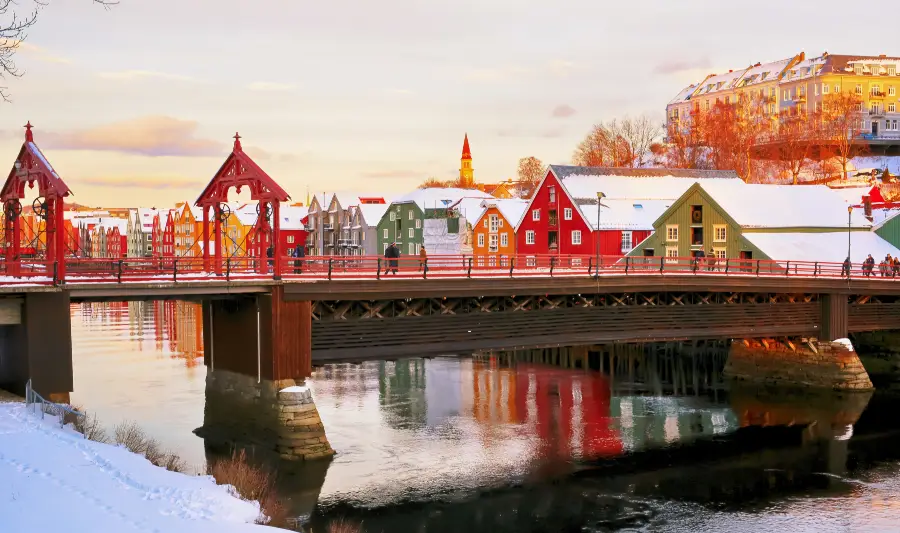
Trondheim Kunstmuseum and The National Museum of Decorative Arts and Design
Near the Nidaros Cathedral, art enthusiasts can explore two of Trondheim’s finest museums: the Trondheim Kunstmuseum and the National Museum of Decorative Arts and Design. The Trondheim Kunstmuseum, also known as the Trondheim Art Museum, showcases numerous permanent and temporary exhibitions, boasting a rich collection of artworks by Norwegian painters from the 19th and 20th centuries.
On the first floor, visitors will encounter renowned figures of Norwegian art, such as Harald Sohlberg with “Night” (Røros Church) and Peder Balke with “North Cape”. The second floor features contemporary Norwegian and international artists.
On the other hand, the National Museum of Decorative Arts and Design offers a captivating exploration of local art and craftsmanship. Established in 1893, it houses an impressive array of local craftsmanship, Norwegian silverware and glassware from the 16th and 17th centuries, Art Nouveau furnishings, and some of the finest examples of contemporary Scandinavian design.
Rockheim
One of the most unusual things to do in Trondheim is to visit Rockheim, a modern and eclectic museum dedicated entirely to pop and rock music and located on Brattørkaia, near the harbor. The museum, which is housed in a transformed early 1900s barn, now a colorful masterpiece of modern architecture, offers engaging permanent exhibitions featuring multimedia and interactive installations that trace the history of Norwegian music from the 1950s to the present day.
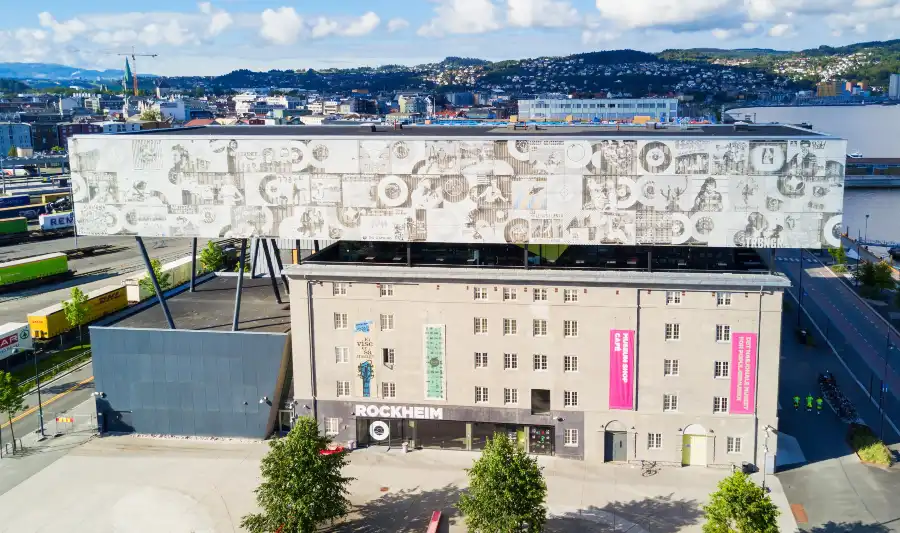
The centerpiece of the museum is “The Time Tunnel” : this expansive exhibition, spread over 1320 square meters, chronicles the evolution of Norwegian music and culture from the emerging youth culture of the 1950s to the contemporary music scene. The exhibition also provides interactive audio, images, and videos for an immersive experience. Another highlight of Rockheim is the “Hall of Fame”, which honors artists who have significantly contributed to the development and popularization of Norwegian music. This section allows you to delve into the lives of these artists through unique content such as videos, images, biographies, and artifacts.
In addition to its permanent exhibitions, Rockheim also hosts temporary exhibitions that explore various aspects of music history and contemporary culture. If you’re traveling with children, a visit to Rockheim could be a fantastic activity. The museum offers interactive experiences such as playing the electric guitar like a rock star, learning to use turntables like a professional hip-hop DJ, or even controlling the world’s largest midi controller to create electronic music in a fun and intuitive way.
Trondheim Science Museum
The Trondheim Science Museum (Vitensenteret i Trondheim) is one of our favorites in Trondheim. Whether it’s because of our scientific background or our occasional desire to relive our childhood, this museum is definitely worth a visit, especially if you’re traveling with children. In fact, we would rank it among the best things to do in Trondheim with kids!
This museum, located just a short walk from the train station and city center, offers the opportunity to learn many interesting things about the human body, physics, chemistry, and science in general, through exciting activities, experiments, and interactive installations for the whole family.
Here, you will find Norway’s first and only 3D planetarium and 360-degree cinema, interactive rooms with films and multimedia installations. But the best part is the laboratories where both adults and children can have fun with experiments. There are chemistry and biology labs, as well as rooms where you can experiment with robots. Also, don’t forget to check out the museum shop, where they sell experiment kits, so children can continue to play and learn about science at home.
Munkholmen
Munkholmen, also known as Monk’s Island, is a fortified island steeped in history, nestled in the Trondheim Fjord near the mouth of the Nidelva River. It was once an execution site during the Viking era, gaining a notorious reputation. In the 11th century, it became home to one of the first Benedictine monasteries in the Scandinavian countries. The island underwent further transformations in the 17th century when it was converted into a fortress and prison. During World War II, it served as a German defensive site, with anti-aircraft guns positioned to protect their Dora Submarine Base in Trondheim.
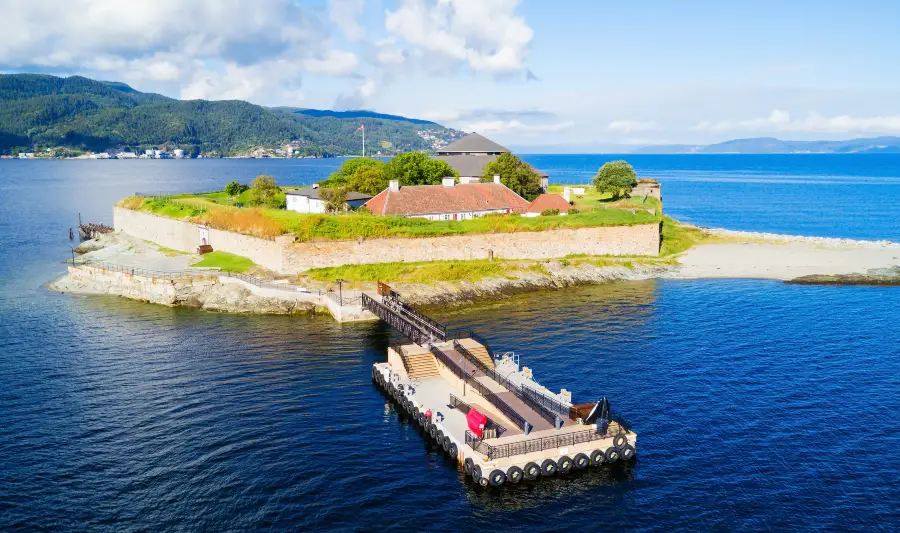
Today, Munkholmen has evolved into a popular summer bathing spot for both locals and tourists. Visitors can still see remnants of its past, including the well-preserved round tower from the former Benedictine abbey and sections of the ancient defensive walls.
The island offers guided tours in English and Norwegian, allowing visitors to explore the old fort, the prisons, and the remains of the monastery. Alternatively, visitors can enjoy a leisurely stroll around the island. Munkholmen also hosts a small bar that serves a variety of food and beverages. From May to September, regular boat services depart every hour from Munkegata 70 in Trondheim. Check the schedule here.
Solsiden District
Solsiden, a small and vibrant neighborhood nestled in the Nedre Elvehavn district, is just a short stroll from the city center and adjacent to the marina near Blomsterbrua, the Flower Bridge. Aptly named “the sunny side” in Norwegian, Solsiden is renowned for its lively ambiance and spirited character. This neighborhood, emerged from the remnants of an old shipyard, exemplifies the successful architectural restoration and transformation of a previously deteriorated area.
As you wander through its streets, which essentially form an open-air shopping center, you can soak in the post-industrial vibe accentuated by contemporary architecture. Solsiden’s popularity stems from its reputation as a prime spot for nightlife and social gatherings. It’s a favored destination for both locals and tourists, boasting a plethora of restaurants and bars. Additionally, Solsiden is home to a large, modern shopping center teeming with a variety of shops and retail opportunities.
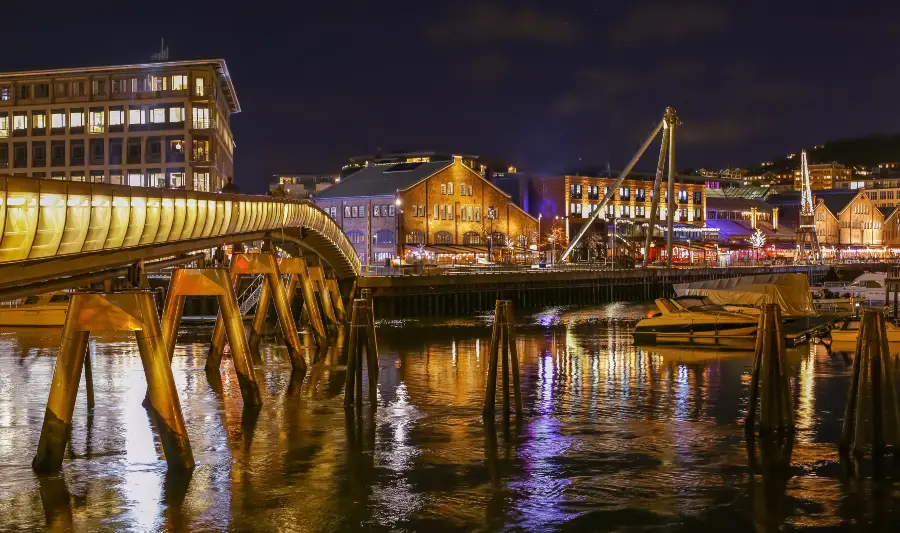
One of the main attractions of Solsiden is the marina’s waterfront, speckled with restaurants and bars featuring outdoor terraces. These spots are perfect for basking in the sun with friends while savoring delectable food. The area offers a range of pizzerias, bars, and restaurants serving international cuisine. Local favorites include Una Pizzeria, Olivia Restaurant, and Héctor Food & Fiesta, known for its Mexican-inspired dishes. For a casual night out, consider Søstrene Karlsen, San Sebastian, Sot Bar & Burger Solsiden, Café Løkka, and Cowsea.
During winter, the dock of the old shipyard transforms into a floodlit ice-skating rink. In contrast, summer sees it morph into a concert and festival stage, attracting both local and international music stars. The repurposed pump house, now known as Dokkhuset, serves as a modern venue hosting local and international artists and musicians. Managed by the Norwegian University of Science and Technology, it’s also an ideal spot to partake in the Norwegian tradition of utepils – outdoor beer drinking – on a sunny day.
Art enthusiasts will appreciate the Trondheim Kunstmuseum Gråmølna, a branch of the Trondheim Art Museum. Housed in a renovated mill dating back to 1840, this quaint museum showcases both permanent and temporary exhibitions by local artists.
Tyholttårnet
Tyholttårnet is the iconic tower that defines the skyline of Trondheim. This radio tower, located just outside the city center, was erected in 1985 and stands at 124 meters tall, making it the tallest building in Norway. At the top, about 70 meters high, there is an observation platform and on the upper floor is the revolving restaurant Egon Tårnet, which completes a full rotation every hour, offering a diverse menu ranging from meat and fish to vegetarian options.
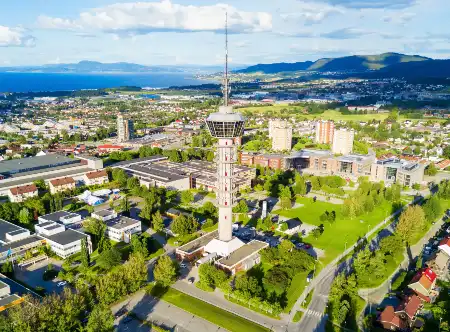
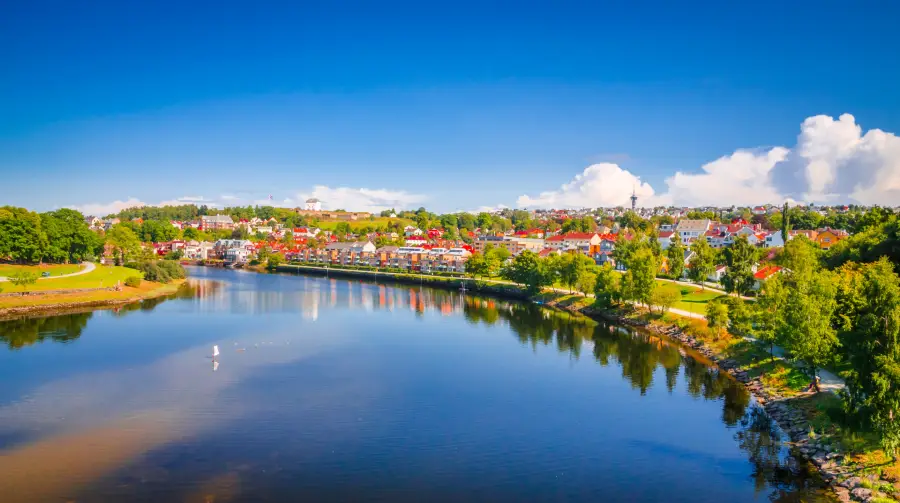
Visitors can ascend to the observation deck free of charge to admire the cityscape, or choose to dine at the restaurant while enjoying the view. Located approximately 2.5 km from the city center, the tower is easily accessible. You can take tram 22 from Prinsens Gate, which runs parallel to the back of Torvet, and alight at the Strinda vgs stop, situated at the base of the tower.
CycloCable
Certainly, one of the most unique attractions in Trondheim is the CycloCable, the only ski lift in the world designed for cyclists. Trondheim, a city that embraces cycling, introduced this ingenious system in 1993 to assist cyclists with the challenging 20% gradient climb near the Old Town Bridge (Gamle Bybro) in Bakklandet. The current version of the CycloCable is an enhancement of the original design, the brainchild of Jarle Wanvik, a local resident who sought a solution to the exhausting uphill commute to work. This innovative system underscores Trondheim’s commitment to promoting a cycling-friendly environment.
Stiftsgarden
Nestled in the heart of Trondheim, the elegant Stiftsgården villa stands as a splendid example of 18th-century Baroque architecture. Its bright yellow hue makes it easily recognizable, and it currently serves as the official residence of the Norwegian Royal Family during their visits to Trondheim.
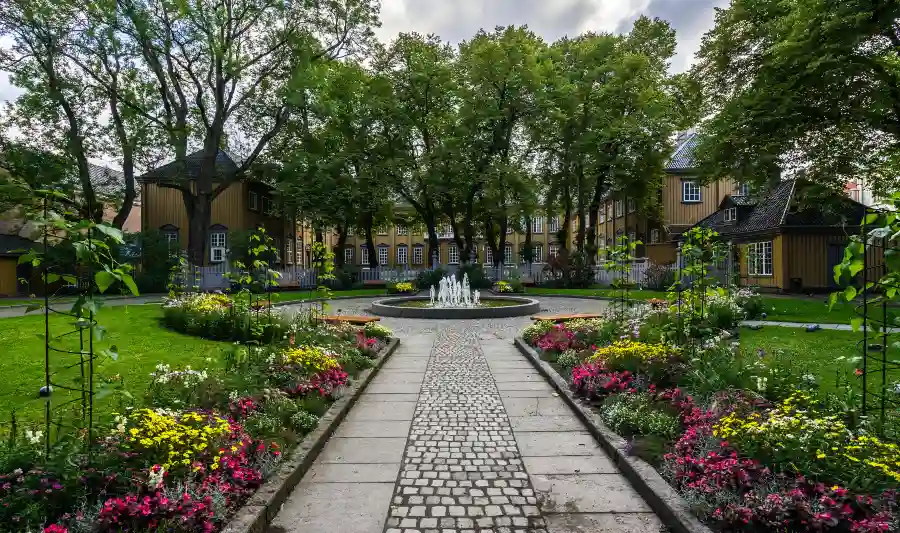
Constructed in 1778, Stiftsgården was originally the private residence of Cecilie Christine Schøller, a wealthy Norwegian socialite, landowner, and entrepreneur. The residence, designed by General G.F. von Krogh, showcases the Rococo style with Baroque details. Although it had been hosting royals since the 1800s, it only became state property in the early 1900s.
Stiftsgården is one of Europe’s most imposing wooden structures and a prime example of Norwegian architecture. It boasts over 100 rooms, each richly decorated. Visitors can explore the villa by participating in one of the guided tours, which are typically available from June to August. These 45-minute tours offer glimpses into some of the palace’s rooms, such as the lavishly decorated dining room, while the guide narrates the building’s history. You can check schedules and tickets here, noting that they become available as the summer season approaches.
Trondheim Maritime Museum
The Trondheim Maritime Museum, housed in one of the city’s oldest brick buildings, a former 18th-century prison, pays homage to Trondheim’s rich seafaring and commercial history, tracing the evolution of navigation from the 17th century to the present day. The exhibition embarks on a journey starting with the era of sail navigation, then transitions to the advent of steam navigation—a revolutionary shift that profoundly influenced maritime activities and trade.
The narrative continues with a section dedicated to the sailors’ life aboard ships, marked by strenuous labor, long working hours, harsh living conditions, and often substandard food. The exhibit further explores Trondheim’s naval industry during this period, highlighting the city’s role as a significant shipbuilding and maintenance hub, and its exponential growth as it emerged as a crucial trading center.
The museum showcases a diverse collection that includes models of sailing ships and steamboats of various sizes, figureheads, onboard instruments, and a range of photos and paintings related to navigation. It also houses a library filled with books on maritime history and ships.
The second floor offers an array of engaging activities for children. Here, a ship’s deck has been meticulously recreated, complete with sound and light effects. Children can learn to tie various knots, draw, solve puzzles, search for a secret room, or listen to the intriguing tales of Sivert’s family, the ship’s mouse. The museum is situated along the banks of the Nidelva River, 800 meters from the city center and can be easily reached with a brief 10-minute walk.
Pirbadet
If you’re spending some time in Trondheim, you might want to consider spending a relaxing day at Pirbadet, the largest indoor water park in Norway. This water park is a hit among families and serves as an excellent retreat on rainy days. It features various children’s pools, diving towers, water slides, wave pools, water climbing walls, sports pools, and a large heated outdoor pool. Additionally, it boasts a lovely wellness center complete with hot tubs and saunas. It’s a place where fun and relaxation go hand in hand.
Ladestien Trail
The Ladestien is an 8 km hiking trail meandering along the Trondheim Fjord on the Lade Peninsula. It offers a journey through panoramic promontories, pristine nature, and lush forests. With an elevation change of about 130 meters, the trail is relatively easy and requires no significant physical exertion. It typically takes around 2-3 hours to traverse the entire trail. The trail commences at the end of Ormen Langes Vei (map) on the peninsula’s western side and concludes on the opposite side at Rotvoll (map).
Along the way, you’ll encounter the “Flytende, flyvende” monument, a tribute to Leif Erikson, who is believed to be the first European to land on the American continent around 1000 BC, nearly five centuries before Christopher Columbus. The trail descends towards Korsvika, one of Trondheim’s most renowned bathing beaches, offering a stunning view of the fjord. You’ll also pass a series of old German bunkers from the WWII and the old Lade pier, which served as a military port during World War II, as well as numerous fjord inlets, pebble beaches, caves, ancient villages, and farms.
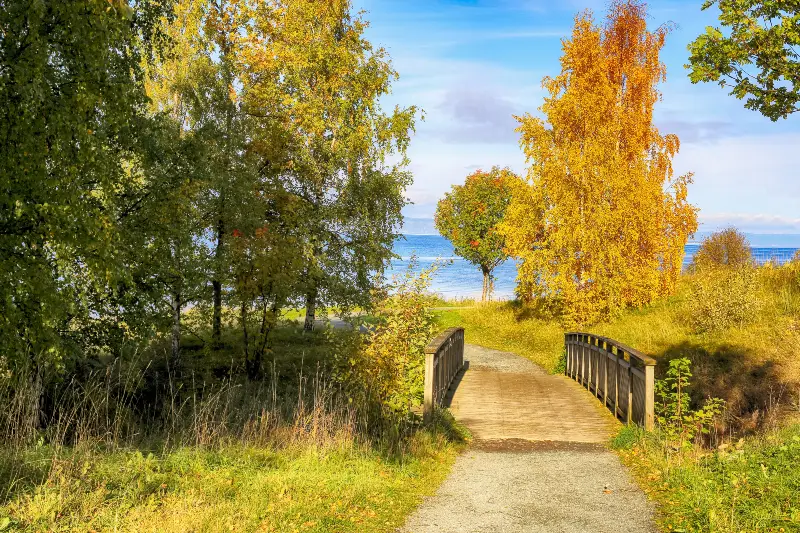
Bus 20 serves the start and end points of the trail and also provides a connection to the center of Trondheim. To reach the starting point at Ormen Langes Vei you can take bus 20 at Prinsens Gate, alight at Strandveikaia, proceed along Ormen Langes Vei, and walk about 800 meters to the trailhead. Alternatively, you can commence the route at Korsvika by taking the same bus but alighting at Krutthusbakken, which is just 100 meters from the beach.
For the return journey from Rotvoll, you can walk about 1 km to Ranheimsvegen and take bus 20 back to the city center. If you’re driving, you can take bus 20 back to the starting point after completing the trail. Alternatively, the trail is only a 3.5 km walk directly from the city center. Here the trail map.
Skiing at Fjellseter Gråkallen
Trondheim is also a popular skiing destination and is home to Mount Fjellseter, located just a few kilometers away. Despite its modest height of 367 meters, it provides an ideal setting for a day of skiing fun. The mountain houses a well-furnished ski resort and even features a ski jump. During the summer, the area transforms into a hiker’s paradise. Hikers can embark on leisurely treks to the summit of Gråkallen, standing at 555 meters, and be rewarded with a stunning view of the Trondheim Fjord.
While the most convenient way to reach the location is by car, public transportation is also an option. If you’re relying on the latter, you can take bus 26 from Kongens gate, near Torvet, and alight at Fjellseterveien, the starting point of the main hiking trails.
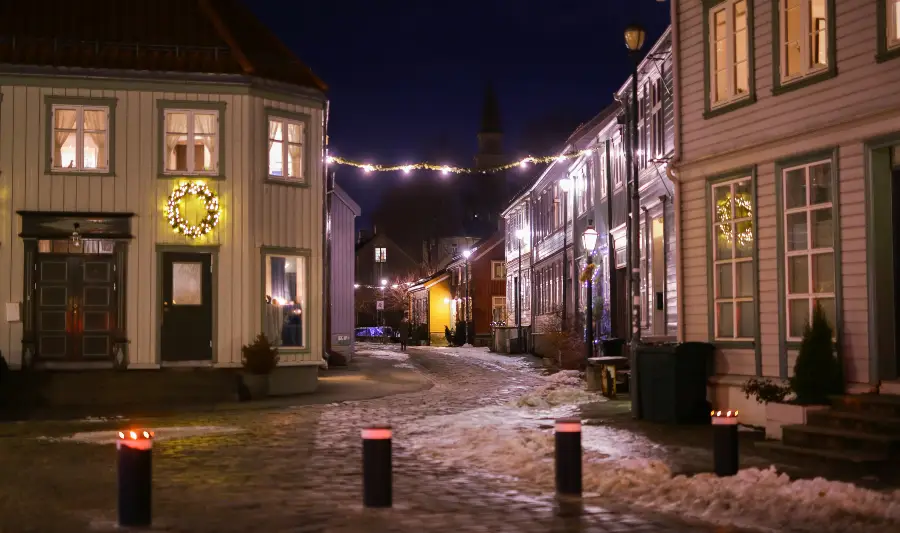
Best Places to Eat in Trondheim
Experiencing the vibrant food scene is undoubtedly one of the best things to do in Trondheim. The city is home to several Michelin-starred restaurants. Among them is FAGN, renowned for its exceptional contemporary culinary creations. It offers an intriguing tasting menu that starts at NOK 1600. Nestled within the elegant Britannia Hotel is Speilsalen, yet another Michelin-starred establishment. It provides an exceptional fine dining experience, offering tasting menus (starting from NOK 2250), a selection of the finest champagnes, and a prestigious caviar bar.
For those seeking a more casual dining experience, To Rom og Kjøkken is a great choice. This restaurant serves delicious Scandinavian specialties, all made with the freshest local, organic ingredients. Bula Neobistro is another popular spot among locals. This friendly restaurant serves fantastic menus inspired by international cuisine, all prepared with high-quality, fresh local ingredients. If you’re in the mood for a good drink and want to explore the city’s vibrant drinking scene, you might want to check out our guide to the best Bars in Trondheim. It features a selection of our favorite pubs, local bars, and breweries.
How to Get to Trondheim
Trondheim is easily reachable from Bergen, Oslo, and Bodø, and is a favored stop for cruise travelers. Many visitors opt to explore it during a breathtaking road trip through the Norwegian Fjords, or as a pit stop on a train journey traversing the railway that spans across Central Norway.
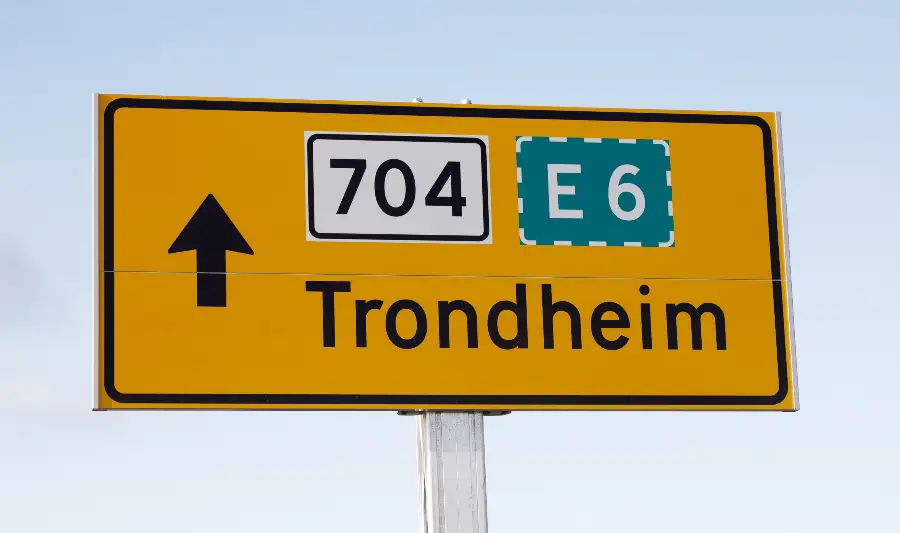
Getting to Trondheim by Car
Traveling by car is undoubtedly one of the best ways to reach Trondheim and take in the stunning scenery of the Trondheim Fjords. You can rent a car in one of Norway’s major cities and reach Trondheim via the Norwegian North-South Highway E6 or the Coastal Highway E39 to Klett, and from there, continue on the E6 to Trondheim. You can find the best car rental deals on Rentalcars.com or Discovercars.com, which allow you to view the best real-time prices from reliable car rental companies.
For a more scenic route, consider driving from Oslo to Trondheim on the Norwegian National Road 3 (Rv3), also known as “The Green Shortcut”.
Getting to Trondheim by Plane
Located just 19 km from the heart of Trondheim, Trondheim Airport, also known as Trondheim Værnes Airport, provides excellent connectivity to the city center. With both express trains and buses at your disposal, you can expect convenient and swift transportation options.
Serving as a crucial hub for both international and domestic flights, this airport is an ideal gateway to Trondheim. It is often one of the quickest and sometimes the most cost-effective means of reaching Trondheim from major cities such as Bergen, Oslo, and Tromsø.
Getting to Trondheim by the Hurtigruten coastal express
The legendary coastal express Hurtigruten makes daily stops at Trondheim, both on its northbound and southbound routes. The ship docks in port for approximately 3 hours, providing enough time for a brief exploration of the city. For travelers wishing to fully experience Trondheim, purchasing a port-to-port ticket is advisable. This allows for a longer stay of a day or two in the city before boarding one of the subsequent ships.
Getting to Trondheim by Train
Trondheim is served by the railway line that connects Oslo with Bodø. The train station is conveniently located within walking distance from both the port and the city center, making it a practical and cost-efficient solution for tourists and business travelers alike. There are daily trains to and from Oslo (a journey of about 7 hours) and to and from Bodø (a journey of about 10 hours). However, there are no direct connections to Bergen.
Getting to Trondheim by Bus
Trondheim can also be reached by long bus trips from Oslo, Bodø, Ålesund, and from inland towns such as Stryn and Otta. However, there are no direct buses from Bergen.
Tips for your trip to Trondheim
Planning your trip to Trondheim? Take a look at our guides, filled with all the best local advice to help you plan your trip effectively. If you’re searching for the perfect accommodation for your stay, you might want to check out our guide to the Best Hotels in Trondheim, while if you’re traveling on a budget, our guide to Cheap Hotels in Trondheim features a selection of decent, clean, and safe places that rank among the most affordable in town.
If you’ll be traveling by air, our guide to Trondheim Airport could be useful. It includes practical tips on how to get from the airport to the city center and vice versa, information on airport hotels, and other helpful advice.